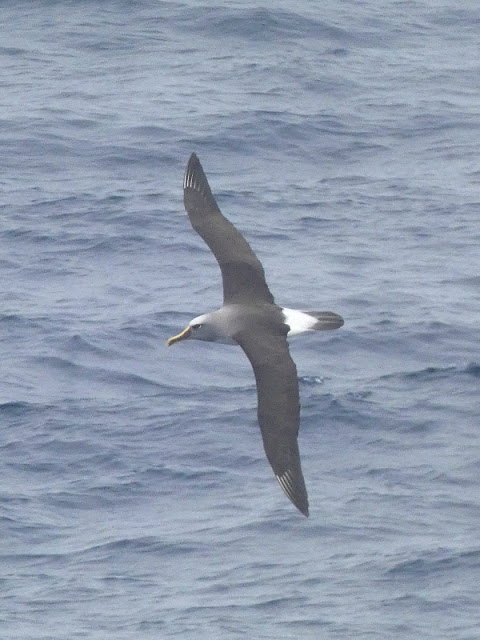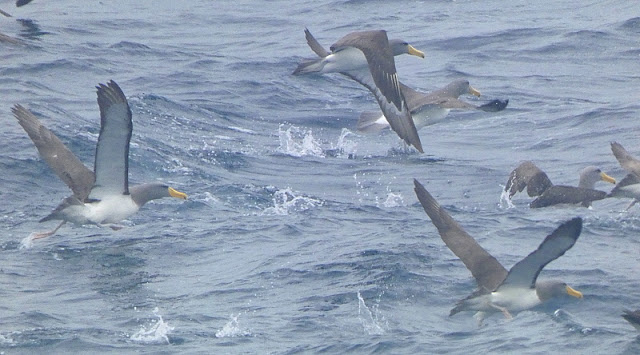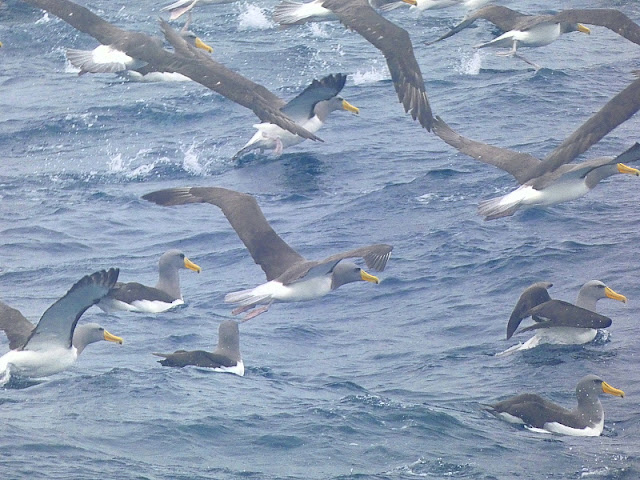Sunday
17 December. I was on deck from 05:25. Visibility was poor
with sea mist more on than off. We sailed towards Pyramid Rock with the bottom quarter
becoming visible as we approached. We circumnavigated the rock several times
with more and more of it emerging as the fog slowly lifted. It was not the way
I had hoped to see one of the most spectacular seabird colonies and it left me
feeling a bit disappointed although the numbers of Chatham Albatrosses on the
only colony in the world was impressive. Attempts to relocate some to another nearby island have been unsuccessful with birds soon returning to the Pyramid. We
continued north to the almost completely wooded South East Island. After lunch with the sun having burned up
all the fog we had a two hour Zodiac cruise along the shore, landing being not
allowed. We were in one of the last Zodiacs to depart but soon saw a very obliging Buller’s Albatross sat on the sea, some rather shy Little Penguins that briefly surfaced nearby and Shore Plover
and Chatham Oystercatcher on the rocky beach. We followed the Zodiac ahead of us into a bay and were almost
alongside it when they shouted 'Black Robin' and Zodiacs converged from every
direction. We were in a good position with the bird flicking back and forth several times across a dark wooded gully that opened out onto the beach. The Black Robin stayed within the forest about 60m away and most of the time seemed to settle out of sight but I saw it perched in the open once before it flew again. Although the views weren’t special and the bird hardly spectacular its history more than made up for it. Seeing Black Robin encouraged me to hunt out OLD BLUE The Rarest Bird in the World by Mary Taylor on my return.
The species was down to just two females (named Blue and Green for their colour rings) and three males in 1980. Green's eggs rarely hatched and when they did the chicks didn't survive. Blue was just as unsuccessful until she paired with a younger male Yellow. Don Merton and a pioneering new conservation technique known as cross fostering brought them back from the brink and the population is now about 300. All descended from Old Blue, as she became known living to 13 years, and Yellow. Back on board we cruised around the
coast of Pitt Island, past Little Mangere Island (a brief look for Forbes’
Parakeet, seen distantly in flight by some)
before positioning off the Main Island's ‘Horns’ in the hope of a Magenta or Chatham Petrel returning to their burrow in the Sweetwater Reserve. Our lack of success was
unsurprising when we learned the following day that for both species at this time of year
one parent would be incubating while the other forages in deep water and returns
to their burrow in the dark. We hung on until dusk and then headed around Main Island to anchor in Waitangi Bay.
Birds
seen: 4 Chatham Oystercatchers, 12 Shore
Plovers, Chatham Snipe heard, 20 Red-billed
and 20 Kelp Gulls, 30 White-fronted Terns, 6 Brown Skuas,
5 Little Penguins, 625 White-faced Storm-Petrels, 2 Southern
and 9 Northern Royal, 2000+ Chatham,
2 Salvin’s and 6 Buller’s Albatrosses, 5 Northern Giant
and 20 Cape Petrels, 20 Antarctic Prions, a Buller’s
and 1500 Sooty Shearwaters, 2 Common Diving-Petrels, 20 Pitt
and 50 Chatham Shags, Swamp Harrier, Red-crowned
Parakeet, 4 Tui, New Zealand Fantail, Black
Robin and 4 Starlings.
 |
| first views of Pyramid Rock as the fog very slowly cleared |
 |
| Chatham Albatross at Pyramid Rock |
 |
| Northern Royal Albatross at Pyramid Rock |
 |
| Buller's Albatross at Pyramid Rock |
 |
| Buller's Albatross at Pyramid Rock (photo: Paul Noakes) |
 |
| Chatham Albatrosses nesting on Pyramid Rock (photo: Paul Noakes) |
 |
| Chatham Albatrosses on Pyramid Rock |
 |
| Chatham Albatross at Pyramid Rock (photo: Paul Noakes) |
 |
| Chatham Albatrosses off Pyramid Rock |
 |
| Northern Royal Albatross off the Chathams |
 |
| White-fronted Tern (photo: Paul Noakes) |
 |
| Buller's Albatross from our Zodiac |
 |
| Pitt Shag on South East Island |
 |
| Subantarctic Fur Seals |
 |
Subantarctic Fur Seal on South East Island (photo: Paul Noakes)
|
 |
| Tui on South East Island |
 |
| Shore Plovers on South East Island |
 |
| Shore Plover on South East Island (photos: Paul Noakes) |
 |
| Black Robin on South East Island (unknown photographer in the Zodiac to our left!) |

 |
| Chatham Oystercatcher on South East Island |
 |
| Pyramid Rock |
 |
| repositioning past a heavily grazed Pitt Island |
Monday
18 December. Today was hopefully Magenta Petrel day and we
along with almost 80 others had signed up for the Taiko tour to the Sweetwater
Reserve. We were in the first group and at 06:15 were shuttled by Zodiac to
Waitangi Wharf, although it was still a wet landing. A bus was waiting to take
us (now 27 strong) to the Awatotara Reserve where the tarmac ended. Waiting or
arriving soon after were seven 4x4s, including the Islands Police’s, that had
been roped in to ferry us to Sweetwater 25 minutes drive away. There, after a
brief introduction, Dave Boyle took us through the impressive predator fence
and into the reserve. We followed him to a small clearing where we squeezed
around him in a semicircle. Behind him was a burrow occupied by a non-breeding
male Magenta Petrel. He carefully reached in and lifted the bird out,
showing it to us while telling us about the history of the project and a few
facts about the bird’s behaviour. It didn’t seem agitated and many photos later
he returned it to its burrow, told us to wait and disappeared a bit further
into the reserve. He returned a few minutes later with a non-breeding male Chatham
Petrel from a less accessible burrow and gave us similar information about
the species. We had been privileged to see two ultra rare petrels (estimated
populations of 200 and 2000 respectively). Two other groups went in after us
making it a busy day, although Dave and the other locals involved clearly
enjoyed showing off their island and its unique wildlife. We were returned to
the Awatotara Reserve where we birded along the road for a couple of hours. The
endemic Chatham Gerygone took a while but after a couple of
unsatisfactory views along the road I pished in a pair near the start of the
trail. We returned to Waitangi and after a bit of negotiation were taken back
to the Heritage Adventurer via a small Chatham Shag colony, our views
the previous day being rather distant. We were back on board by 16:45 and
seawatching on deck either side of dinner. The Chathams had certainly
delivered.
Birds
seen: 5 Chatham Pigeons, 5 Red-billed and 8 Kelp
Gulls, 7 White-fronted Terns, 100 White-faced Storm-Petrels,
2 Northern Royal, Campbell, 2 Shy, Chatham, 4 Salvin’s
and 2 Buller’s Albatrosses, 4 Northern Giant Petrels, 40 Prion
sp., Magenta and Chatham
Petrels, 150 Sooty Shearwaters, 3 Pitt and
11 Chatham Shags, 2 White-faced Herons, 2 Swamp Harriers,
2 Chatham Gerygones, 7 New Zealand Fantails,
4 Skylarks, 3 Welcome Swallows, 3 Silvereyes, Song
Thrush, 2 Blackbirds, 2 House Sparrows and Chaffinch heard.
 |
| part of the Taiko convoy on Main Island |
 |
| Chatham grassland meets the Sweetwater Reserve |
 |
| quite a difference although the predator proof fence, the top of which is just about visible in this image, is the game changer |
 |
| a big twitch on a remote island, what's not to like |
 |
| the game changing predator fence |
 |
| the tension builds as we head off into the reserve |
 |
| Magenta Petrel burrow (centre left) and nest box lid (centre right) |
 |
| Dave Boyle with an unpaired male Magenta Petrel |
 |
| it was a bit of a handful |
 |
| Dave with the smaller Chatham Petrel |
 |
| Chatham Pigeon on Main Island, low cloud not helping |
 |
| Chatham Pigeon on Main Island (photo: Paul Noakes) |
 |
| New Zealand Fantail on Main Island (photo: Paul Noakes) |
 |
| Chatham Gerygone on Main Island (photo: Paul Noakes) |
 |
| Waitangi Store, Main Island |
 |
| Pitt Shag on Main Island (photo: Paul Noakes) |
 |
| Chatham Shags on Main Island (photos: Paul Noakes) |









































































































